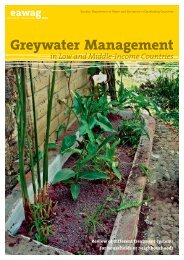Household Water Treatment and Safe Storage Factsheet: Source ...
Household Water Treatment and Safe Storage Factsheet: Source ...
Household Water Treatment and Safe Storage Factsheet: Source ...
Create successful ePaper yourself
Turn your PDF publications into a flip-book with our unique Google optimized e-Paper software.
<strong>Household</strong> <strong>Water</strong> <strong>Treatment</strong> for Arsenic Removal<br />
Fact Sheet: Coagulation-Flocculation<br />
2-Kolshi Filter<br />
Potential <strong>Treatment</strong> Capacity<br />
Very Effective For: Somewhat Effective For: Not Effective For:<br />
Arsenic<br />
Pathogens<br />
Taste, odour, colour<br />
Chemicals<br />
What Is 2-Kolshi?<br />
2-Kolshi is an arsenic removal method using two<br />
buckets, developed by ENPHO in Nepal. The first<br />
step is a coagulation process, followed by a<br />
filtration through a ceramic filter.<br />
How Does It Remove Arsenic?<br />
Coagulation/flocculation is a traditional treatment<br />
process in which the user adds a chemical<br />
coagulant (typically iron sulphate or iron chloride) to<br />
contaminated water. The coagulant helps<br />
precipitate dissolved <strong>and</strong> suspended contaminants<br />
so that they will settle out by gravity or can be<br />
removed by filtration. Using this process, arsenic is<br />
co-precipitated with iron.<br />
In the 2-Kolshi system, iron sulphate is used as a<br />
coagulant. The iron sulphate, sodium hypochlorite<br />
<strong>and</strong> ash are added to the water <strong>and</strong> stirred. During<br />
this process, the arsenic in the water changes form<br />
(As(III) oxidizes to As(V)). The new form of arsenic<br />
can co-precipitate with iron, forming flocs or large<br />
particles. The water is then filtered to remove the<br />
flocs. Ceramic filtration also removes pathogens.<br />
Operation<br />
<br />
<br />
<br />
<br />
Add chemicals (e.g. iron sulphate, sodium<br />
hypochlorite <strong>and</strong> ash) to a bucket of water<br />
Stir water for a few minutes<br />
Let settle for one hour or more<br />
Pass the water through a ceramic filter in the<br />
bottom bucket<br />
Key Information<br />
<strong>Treatment</strong><br />
1 Output Cost<br />
Efficiency<br />
90% arsenic removal<br />
99% microbial<br />
removal<br />
1 (Hwang, 2002)<br />
2-Kolshi System<br />
(Credit: T. Ngai)<br />
3-5 litres/hour<br />
$10 capital cost<br />
$10-20 chemical<br />
cost/year
















